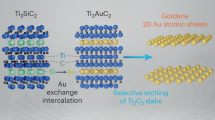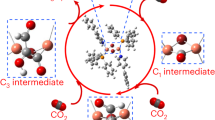Abstract
The electrosynthesis of higher-order alcohols from carbon dioxide and carbon monoxide addresses the need for the long-term storage of renewable electricity; unfortunately, the present-day performance remains below what is needed for practical applications. Here we report a catalyst design strategy that promotes C3 formation via the nanoconfinement of C2 intermediates, and thereby promotes C2:C1 coupling inside a reactive nanocavity. We first employed finite-element method simulations to assess the potential for the retention and binding of C2 intermediates as a function of cavity structure. We then developed a method of synthesizing open Cu nanocavity structures with a tunable geometry via the electroreduction of Cu2O cavities formed through acidic etching. The nanocavities showed a morphology-driven shift in selectivity from C2 to C3 products during the carbon monoxide electroreduction, to reach a propanol Faradaic efficiency of 21 ± 1% at a conversion rate of 7.8 ± 0.5 mA cm−2 at −0.56 V versus a reversible hydrogen electrode.
This is a preview of subscription content, access via your institution
Access options
Access Nature and 54 other Nature Portfolio journals
Get Nature+, our best-value online-access subscription
$29.99 / 30 days
cancel any time
Subscribe to this journal
Receive 12 digital issues and online access to articles
$119.00 per year
only $9.92 per issue
Buy this article
- Purchase on Springer Link
- Instant access to full article PDF
Prices may be subject to local taxes which are calculated during checkout




Similar content being viewed by others
Data availability
The data that support the plots within this paper and other findings of this study are available from the corresponding author upon reasonable request.
References
Lin, S. et al. Covalent organic frameworks comprising cobalt porphyrins for catalytic CO2 reduction in water. Science 349, 1208–1213 (2015).
Asadi, M. et al. Nanostructured transition metal dichalcogenide electrocatalysts for CO2 reduction in ionic liquid. Science 353, 467–470 (2016).
Jiang, K. et al. Metal ion cycling of Cu foil for selective C–C coupling in electrochemical CO2 reduction. Nat. Catal. 1, 111–119 (2018).
Zhuang, T.-T. et al. Steering post-C–C coupling selectivity enables high efficiency electroreduction of carbon dioxide to multi-carbon alcohols. Nat. Catal. 1, 421–428 (2018).
Gao, S. et al. Partially oxidized atomic cobalt layers for carbon dioxide electroreduction to liquid fuel. Nature 529, 68–71 (2016).
Hahn, C. et al. Engineering Cu surfaces for the electrocatalytic conversion of CO2: controlling selectivity toward oxygenates and hydrocarbons. Proc. Natl Acad. Sci. USA 114, 5918–5923 (2017).
Xiao, H., Goddard, W. A., Cheng, T. & Liu, Y. Cu metal embedded in oxidized matrix catalyst to promote CO2 activation and CO dimerization for electrochemical reduction of CO2. Proc. Natl Acad. Sci. USA 114, 6685–6688 (2017).
De Luna, P. et al. Catalyst electro-redeposition controls morphology and oxidation state for selective carbon dioxide reduction. Nat. Catal. 1, 103–110 (2018).
Schouten, K. J. P., Calle‐Vallejo, F. & Koper, M. A step closer to the electrochemical production of liquid fuels. Angew. Chem. Int. Ed. 53, 10858–10860 (2014).
Loiudice, A. et al. Tailoring copper nanocrystals towards C2 products in electrochemical CO2 reduction. Angew. Chem. Int. Ed. 55, 5789–5792 (2016).
Ren, D., Wong, N. T., Handoko, A. D., Huang, Y. & Yeo, B. S. Mechanistic insights into the enhanced activity and stability of agglomerated Cu nanocrystals for the electrochemical reduction of carbon dioxide to n-propanol. J. Phys. Chem. Lett. 7, 20–24 (2016).
Kim, D., Kley, C. S., Li, Y. & Yang, P. Copper nanoparticle ensembles for selective electroreduction of CO2 to C2–C3 products. Proc. Natl Acad. Sci. USA 114, 10560–10565 (2017).
Verma, S., Lu, X., Ma, S., Masel, R. I. & Kenis, P. J. The effect of electrolyte composition on the electroreduction of CO2 to CO on Ag based gas diffusion electrodes. Phys. Chem. Chem. Phys. 18, 7075–7084 (2016).
Jhong, H. R. M. et al. A nitrogen‐doped carbon catalyst for electrochemical CO2 conversion to CO with high selectivity and current density. ChemSusChem 10, 1094–1099 (2017).
Kuhl, K. P., Cave, E. R., Abram, D. N. & Jaramillo, T. F. New insights into the electrochemical reduction of carbon dioxide on metallic copper surfaces. Energy Environ. Sci. 5, 7050–7059 (2012).
Kortlever, R., Shen, J., Schouten, K. J. P., Calle-Vallejo, F. & Koper, M. T. M. Catalysts and reaction pathways for the electrochemical reduction of carbon dioxide. J. Phys. Chem. Lett. 6, 4073–4082 (2015).
Seifitokaldani, A. et al. Hydronium-induced switching between CO2 electroreduction pathways. J. Am. Chem. Soc. 140, 3833–3837 (2018).
Li, C. W., Ciston, J. & Kanan, M. W. Electroreduction of carbon monoxide to liquid fuel on oxide-derived nanocrystalline copper. Nature 508, 504 (2014).
Verdaguer-Casadevall, A. et al. Probing the active surface sites for CO reduction on oxide-derived copper electrocatalysts. J. Am. Chem. Soc. 137, 9808–9811 (2015).
Xiao, H., Cheng, T. & Goddard, W. A. III Atomistic mechanisms underlying selectivities in C1 and C2 products from electrochemical reduction of CO on Cu(111). J. Am. Chem. Soc. 139, 130–136 (2016).
Yang, K. D. et al. Morphology‐directed selective production of ethylene or ethane from CO2 on a Cu mesopore electrode. Angew. Chem. Int. Ed. 56, 796–800 (2017).
Zheng, G. et al. Interconnected hollow carbon nanospheres for stable lithium metal anodes. Nat. Nanotech. 9, 618–623 (2014).
Li, Z. et al. A sulfur host based on titanium monoxide@carbon hollow spheres for advanced lithium–sulfur batteries. Nat. Commun. 7, 13065 (2016).
Wu, H.-L. et al. Formation of pseudomorphic nanocages from Cu2O nanocrystals through anion exchange reactions. Science 351, 1306–1310 (2016).
Kuo, C.-H. & Huang, M. H. Fabrication of truncated rhombic dodecahedral Cu2O nanocages and nanoframes by particle aggregation and acidic etching. J. Am. Chem. Soc. 130, 12815–12820 (2008).
Mistry, H. et al. Highly selective plasma-activated copper catalysts for carbon dioxide reduction to ethylene. Nat. Commun. 7, 12123 (2016).
Sen, S., Liu, D. & Palmore, G. T. R. Electrochemical reduction of CO2 at copper nanofoams. ACS Catal. 4, 3091–3095 (2014).
Favaro, M. et al. Subsurface oxide plays a critical role in CO2 activation by Cu(111) surfaces to form chemisorbed CO2, the first step in reduction of CO2. Proc. Natl Acad. Sci. USA 114, 6706–6711 (2017).
Rasul, S. et al. A highly selective copper–indium bimetallic electrocatalyst for the electrochemical reduction of aqueous CO2 to CO. Angew. Chem. Int. Ed. 7, 2146–2150 (2015).
Thang Dinh., C. et al. CO2 electroreduction to ethylene via hydroxide-mediated copper catalysis at an abrupt interface. Science 360, 783–787 (2018).
Hori, Y., Takahashi, R., Yoshinami, Y. & Murata, A. Electrochemical reduction of CO at a copper electrode. J. Phys. Chem. B 101, 7075–7081 (1997).
Unver, A. & Himmelblau, D. Diffusion coefficients of CO2, C2H4, C3H6 and C4H8 in water from 6 to 65 °C. J. Chem. Eng. Data 9, 428–431 (1964).
Hao, L. & Leaist, D. G. Binary mutual diffusion coefficients of aqueous alcohols. Methanol to 1-heptanol. J. Chem. Eng. Data 41, 210–213 (1996).
Cussler, E. L. Diffusion: Mass Transfer in Fluid Systems (Cambridge Univ. Press, Cambridge, 2009).
Waszczuk, P., Zelenay, P. & Sobkowski, J. Surface interaction of benzoic-acid with a copper electrode. Electrochim. Acta 40, 1717–1721 (1995).
Acknowledgements
This work was supported by the Ontario Research Fund Research-Excellence Program, the Natural Sciences and Engineering Research Council (NSERC) of Canada, the CIFAR Bio-Inspired Solar Energy program and University of Toronto Connaught grant. The authors thank T. P. Wu, Z. Finfrock and L. Ma for technical support at the 9BM beam-line of the Advanced Photon Source (Lemont, IL). This research used resources of the Advanced Photon Source, an Office of Science User Facility operated for the US Department of Energy (DOE) Office of Science by Argonne National Laboratory and was supported by the US DOE under Contract no. DE-AC02-06CH11357, and the Canadian Light Source and its funding partners. S.H.Y. acknowledges funding from the National Natural Science Foundation of China (Grant 21431006) and the Foundation for Innovative Research Groups of the National Natural Science Foundation of China (Grant 21521001). The authors thank X. Wang and A. Seifitokaldani from the University of Toronto for fruitful discussions.
Author information
Authors and Affiliations
Contributions
E.H.S. and D.S. supervised the project. T.-T.Z. designed the structures, carried out the experiments and wrote the paper. Y.P. carried out the FEM simulations. Z.Q.L. and Y.L. helped to synthesize the catalysts and collect the electroreduction performance data. Z.W. helped to do the DFT simulations. C.-S.T. and P.-L.H. helped to characterize the morphology of the catalyst. J.L. performed the X-ray spectroscopy measurements. M.L., A.P. and A.J. carried out the grazing incidence wide-angle X-ray scattering measurements. All the authors discussed the results and assisted during the manuscript preparation.
Corresponding authors
Ethics declarations
Competing interests
The authors declare no competing interests.
Additional information
Publisher’s note: Springer Nature remains neutral with regard to jurisdictional claims in published maps and institutional affiliations.
Supplementary information
Supplementary Information
Supplementary Methods, Supplementary Figures 1–18, Supplementary Tables 1–5 and Supplementary References
Rights and permissions
About this article
Cite this article
Zhuang, TT., Pang, Y., Liang, ZQ. et al. Copper nanocavities confine intermediates for efficient electrosynthesis of C3 alcohol fuels from carbon monoxide. Nat Catal 1, 946–951 (2018). https://doi.org/10.1038/s41929-018-0168-4
Received:
Accepted:
Published:
Issue Date:
DOI: https://doi.org/10.1038/s41929-018-0168-4
This article is cited by
-
Nanoconfinement-triggered oligomerization pathway for efficient removal of phenolic pollutants via a Fenton-like reaction
Nature Communications (2024)
-
Nanocurvature-induced field effects enable control over the activity of single-atom electrocatalysts
Nature Communications (2024)
-
Nanocavity enriched CuPd alloy with high selectivity for CO2 electroreduction toward C2H4
Rare Metals (2024)
-
Unlocking direct CO2 electrolysis to C3 products via electrolyte supersaturation
Nature Catalysis (2023)
-
Identifying and alleviating the durability challenges in membrane-electrode-assembly devices for high-rate CO electrolysis
Nature Catalysis (2023)



